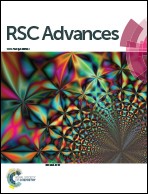Remarkable enhancement of photovoltaic performance of ZnO/CdTe core–shell nanorod array solar cells through interface passivation with a TiO2 layer†
Abstract
All-inorganic solid-state ZnO/CdTe core–shell nanorod array solar cells (NRASCs) have been fabricated by a simple low-temperature and low-cost chemical solution method. A thin TiO2 layer with different thickness was introduced at the ZnO/CdTe interface using atomic layer deposition and its effect on the photovoltaic performance of the NRASCs was investigated. It is found that the overall power conversion efficiency of the ZnO/TiO2 (4 nm)/CdTe NRASC can reach up to 1.44% under AM 1.5G illumination (100 mW cm−2), which is about 6 times of the NRASC without TiO2 layer. By further systematic characterizations, we find that the thin TiO2 layer, serving as an efficient passivation and blocking layer at the interface of ZnO/CdTe nanorod, can remarkably suppress the charge recombination at the interface but negligibly affect the light absorption and the charge separation efficiency, thus leading to significant increases of the carrier lifetime and the open-circuit voltage of the NRASCs. This result expands the knowledge and opportunities for low-cost, high-performance NRASCs through simple interface engineering.


 Please wait while we load your content...
Please wait while we load your content...